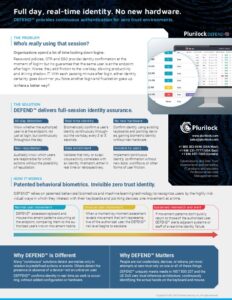Cybersecurity has become a critical concern in our digitally interconnected world. As organizations and individuals strive to protect sensitive information from cyber threats, the need for advanced security measures has intensified. One such innovative approach gaining prominence is Behavioral Biometrics. This cutting-edge technology leverages the unique patterns and habits of users to enhance security. In this deep dive, we will explore what behavioral biometrics is, why it matters in cybersecurity, and delve into an in-depth analysis of its importance.
Understanding Behavioral Biometrics
Definition and Basics
Behavioral biometrics involves the analysis and identification of an individual based on their unique behavioral patterns. Unlike traditional biometrics, such as fingerprints or iris scans, which rely on physical attributes, behavioral biometrics focuses on how users interact with devices and systems. It encompasses a wide range of activities, including keystroke dynamics, mouse movements, voice patterns, and even the unique way a person holds and uses their smartphone.
Key Components
- Keystroke Dynamics
One of the fundamental aspects of behavioral biometrics is keystroke dynamics, which analyzes the typing patterns of individuals. This includes factors such as typing speed, key pressure, and the duration between keystrokes. Each person has a distinctive way of typing, creating a unique biometric signature.
- Mouse Movements
Mouse movements provide another layer of behavioral biometrics. Factors such as speed, acceleration, and the trajectory of the mouse can be analyzed to create a unique profile for each user. For instance, someone might move the mouse in a smooth, consistent manner, while another person may exhibit more erratic movements.
- Voice Patterns
Voice recognition is a well-established field, but behavioral biometrics takes it a step further by analyzing the nuances of an individual’s speech patterns. This includes pitch, rhythm, and even changes in voice due to stress or fatigue.
- Gesture Recognition
With the proliferation of touch-enabled devices, gesture recognition has become a significant component of behavioral biometrics. The unique way individuals swipe, pinch, and zoom on their screens can be analyzed for authentication purposes.
- Device Interaction
The manner in which users interact with their devices, including the speed of scrolling, the frequency of app usage, and even the angle at which a device is held, can contribute to the behavioral biometric profile.
Continuous Authentication
One of the key advantages of behavioral biometrics is its ability to provide continuous authentication. Unlike traditional methods that authenticate a user only at the point of login, behavioral biometrics continuously monitor and verify the user’s identity throughout their entire session. This dynamic approach enhances security by adapting to changes in user behavior over time.
Why Behavioral Biometrics Matter in Cybersecurity
Overcoming Traditional Biometric Limitations
While traditional biometrics like fingerprints and iris scans have proven effective, they come with inherent limitations. Fingerprints can be lifted, and iris scans can be compromised. Behavioral biometrics, on the other hand, offers a level of uniqueness that is not easily replicable. Even if an attacker gains access to static biometric data, such as a keystroke pattern, it is challenging to mimic the dynamic nature of a user’s behavior.
Increased Accuracy and Usability
Behavioral biometrics can enhance both accuracy and usability in authentication processes. Since it analyzes patterns inherent in natural user behavior, there is a reduced likelihood of false positives or negatives. This accuracy is crucial in critical sectors such as finance and healthcare, where precision in user identification is paramount.
Additionally, behavioral biometrics can improve usability by eliminating the need for explicit user actions in authentication. Traditional methods often require users to perform specific actions, such as entering a PIN or providing a fingerprint. Behavioral biometrics seamlessly authenticates users without requiring any conscious effort, contributing to a frictionless user experience.
Adaptive Security
One of the significant advantages of behavioral biometrics is its adaptability to changing circumstances. Traditional security measures often fail to account for variations in user behavior due to factors such as stress, fatigue, or changes in environment. Behavioral biometrics, being dynamic and context-aware, can adapt to these variations, providing a more robust and flexible security framework.
Mitigating Insider Threats
Insider threats, where individuals within an organization pose a security risk, are a growing concern. Behavioral biometrics can play a crucial role in identifying anomalous behavior that might indicate a potential insider threat. Unusual patterns, such as accessing sensitive information at odd hours or attempting to bypass established workflows, can trigger alerts, enabling organizations to take proactive measures.
Fraud Prevention
With the rise of online transactions, the need for robust fraud prevention measures is more critical than ever. Behavioral biometrics adds an extra layer of security by analyzing user behavior during financial transactions. Any deviation from established patterns, such as an unusual location or atypical spending behavior, can trigger alerts and prevent fraudulent activities.
In-Depth Analysis of the Importance of Behavioral Biometrics
Biometric Fusion for Enhanced Security
One of the compelling aspects of behavioral biometrics is its potential for fusion with other biometric modalities. By combining behavioral biometrics with traditional methods like fingerprints or facial recognition, organizations can create a more comprehensive and secure authentication system. This multi-modal approach significantly raises the bar for attackers, as compromising multiple biometric factors simultaneously becomes exponentially more challenging.
Privacy Considerations
While behavioral biometrics offer a high level of security, concerns about user privacy must be addressed. Analyzing behavioral patterns inevitably involves collecting and storing sensitive information about individuals. Striking the right balance between security and privacy is crucial, and organizations adopting behavioral biometrics must implement robust privacy policies and secure storage mechanisms.
Machine Learning and Continuous Improvement
Behavioral biometrics relies heavily on machine learning algorithms to analyze and recognize patterns in user behavior. The continuous learning capabilities of these algorithms enable systems to adapt to changes in user behavior over time. This not only enhances accuracy but also ensures that the system remains effective in the face of evolving cyber threats.
Industry-Specific Applications
The importance of behavioral biometrics varies across industries, with specific applications tailored to address sector-specific challenges. In the financial sector, for example, behavioral biometrics can be instrumental in preventing unauthorized access to accounts and detecting fraudulent transactions. In healthcare, it can safeguard patient data by ensuring that only authorized personnel have access to sensitive information.
Challenges and Future Directions
While behavioral biometrics holds immense promise, it is not without challenges. False positives, where legitimate users are incorrectly denied access, and false negatives, where unauthorized users gain access, remain concerns. Improving the accuracy of behavioral biometrics systems, especially in dynamic environments, is an ongoing area of research.
The future of behavioral biometrics is likely to involve advancements in sensor technologies and the integration of additional contextual factors. For instance, incorporating environmental factors, such as ambient light or background noise, could further enhance the accuracy and reliability of behavioral biometrics.
Conclusion
Behavioral biometrics represents a paradigm shift in the field of cybersecurity. By leveraging the unique behavioral patterns of individuals, it provides a dynamic and adaptive approach to user authentication. The continuous monitoring of user behavior, coupled with machine learning capabilities, enhances security and mitigates the risks associated with traditional static biometrics.
The importance of behavioral biometrics in cybersecurity lies in its ability to overcome the limitations of traditional biometric methods, increase accuracy and usability, adapt to changing circumstances, and address specific challenges across various industries. As organizations continue to face evolving cyber threats, the integration of behavioral biometrics into their security frameworks is likely to become not just a choice but a necessity for ensuring the integrity of sensitive information and safeguarding against unauthorized access and fraudulent activities.













